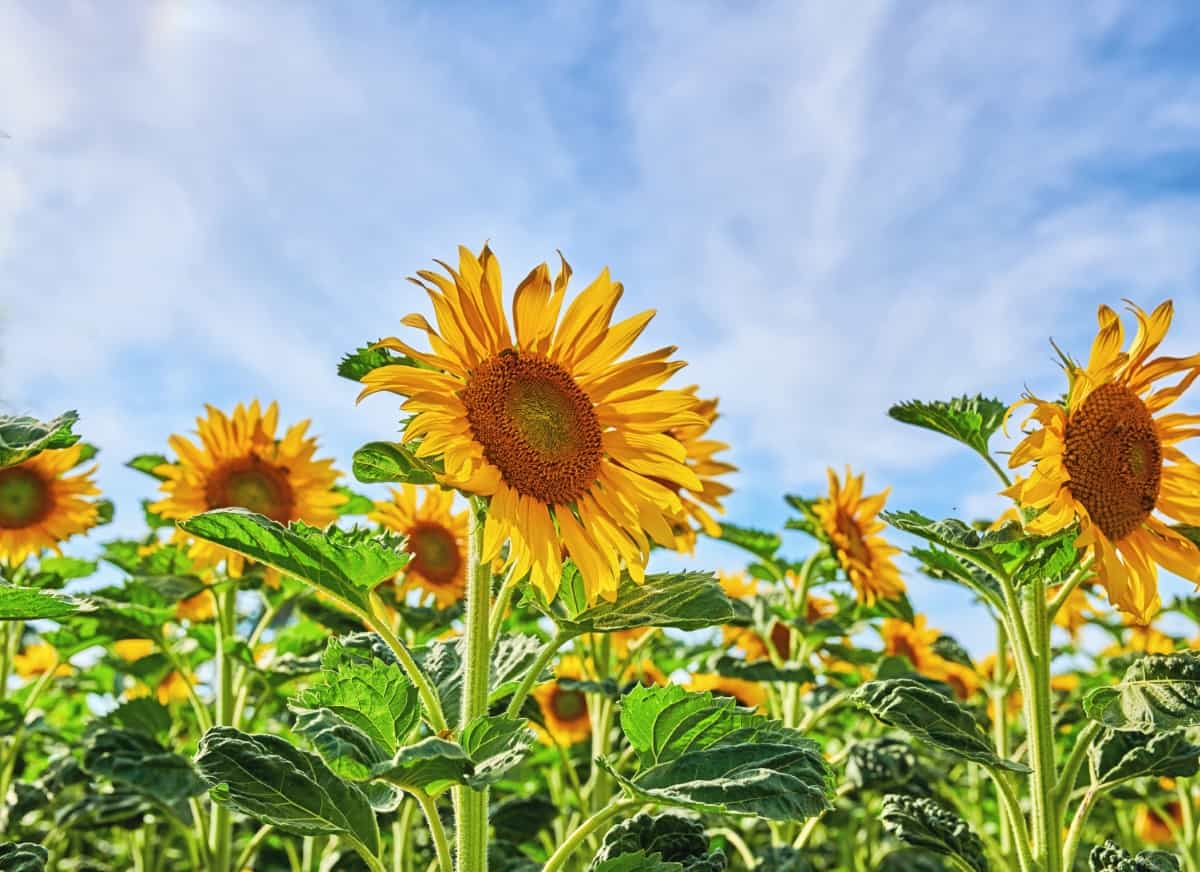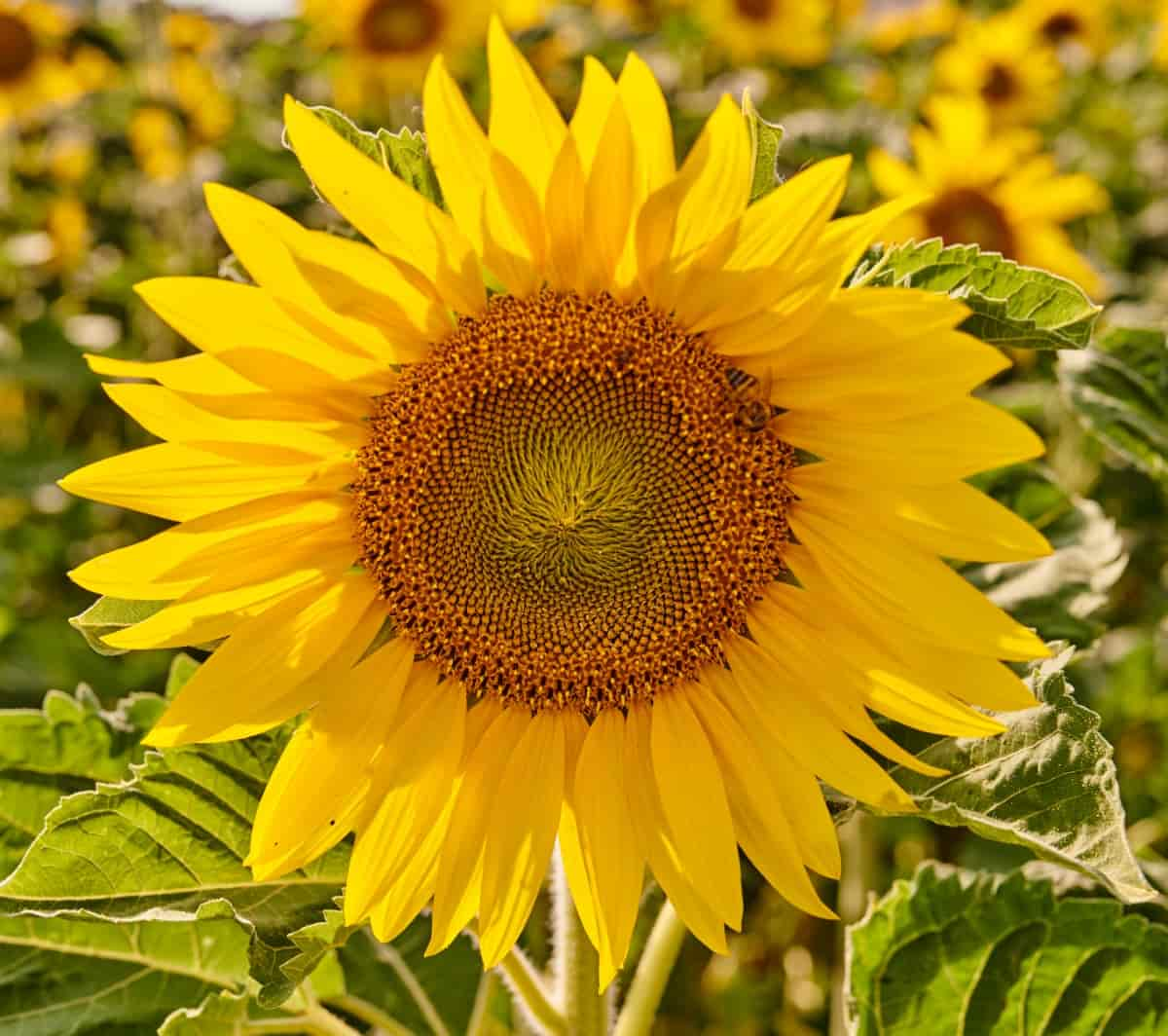One of the most iconic and awe-inspiring plants, the Mammoth Sunflower, has its unique place in gardens. Growing mammoth sunflowers from seed can be an immensely rewarding experience. With the right steps, these plants can reach staggering heights and boast magnificent blooms that instantly become the highlight of any garden. Mammoth Sunflower seeds can grow into plants towering above others in your garden.

Gardeners can ensure these plants reach their full potential by understanding mammoth Sunflower spacing, how long they take to grow, and when to plant Mammoth sunflower seeds. This article will delve into mammoth sunflowers’ various growth stages, from seed germination to harvesting the seeds, exploring Mammoth Sunflower size and seedlings and answering questions such as how tall mammoth sunflower seeds grow.
Growing Mammoth Sunflower from Seed
Selecting the Right Seeds for Mammoth Sunflowers
Choosing the right Mammoth Sunflower seeds is crucial to the success of your gardening venture. While many seed variants exist, ensure you source high-quality, non-GMO, preferably organic Mammoth Sunflower seeds. This guarantees not only healthier growth but also more vibrant blooms.
Preparing the Soil for Planting Mammoth Sunflower Seeds
The foundation of any plant’s growth lies in the soil it’s planted in. Choose a location with at least six hours of sunlight daily for mammoth sunflowers. Opt for soil with effective drainage and a pH ranging from slightly acidic to neutral. Working in a good amount of compost or well-rotted manure enhances its fertility and ensures the mammoth sunflower how long to grow question is answered with optimal results.
Planting Mammoth Sunflower Seeds: When to Plant Mammoth Sunflower Seeds
Planting Mammoth sunflowers at the right time is crucial. The best time is after the last frost when the soil has warmed up sufficiently, usually in late spring. When planting, dig a hole 1 to 2 inches deep, place the seed, and cover it with soil. Respect the Mammoth Sunflower spacing recommendations, keeping plants about 20 to 30 inches apart, ensuring they have ample space to flourish.
Seed Germination for Mammoth Sunflowers: How to Germinate Mammoth Sunflower Seeds
Initiating the journey from a tiny seed to a towering plant, the germination of mammoth Sunflower seeds is an exciting phase. Once planted in moist, well-aerated soil, these seeds will sprout into Mammoth Sunflower seedlings within 7 to 10 days. Maintaining consistent soil moisture, avoiding waterlogging, is essential. Applying a thin mulch layer can help regulate soil temperature and moisture, creating optimal conditions for germination.
In case you missed it: How to Pollinate Sunflowers: Hand Pollination, Natural Pollination Methods, and Tips

Watering and Irrigation Techniques for Mammoth Sunflowers
Nurturing a plant that can stand several feet tall means addressing its hydration needs. Mammoth Sunflowers flourish through consistent deep watering, promoting the development of robust root systems that enhance plant stability. However, allowing the top layer of soil to dry out between watering intervals is essential to prevent waterlogging.
Excessive watering can result in root rot, while insufficient watering might impede growth. A drip irrigation system can be beneficial, ensuring consistent moisture and preventing water from directly hitting the foliage, which can invite diseases.
Fertilizing Mammoth Sunflowers: Nutrient Requirements and Application
Providing essential nutrients to your Mammoth Sunflowers is crucial for optimizing their growth potential. A balanced fertilizer, rich in phosphorus and potassium, promotes robust growth and vibrant blooms. Monthly applications can suffice, but gardeners should avoid high-nitrogen fertilizers. Excessive nitrogen can result in abundant foliage, potentially compromising the quality of the sunflower’s blossoms.
Managing Pests and Diseases in Mammoth Sunflower Plants
Like many plants, Mammoth Sunflowers can become the target of various pests, including aphids and caterpillars. Regular inspection can catch infestations early, and introducing natural predators or applying organic insecticidal soaps can mitigate these problems. Disease-wise, these plants can fall prey to fungal infections. Ensuring appropriate spacing and keeping foliage dry can significantly reduce the risk of diseases.
Pruning and Supporting Mammoth Sunflower Stalks
Given their impressive stature, it’s common for Mammoth Sunflowers to need some support, especially in areas prone to strong winds. Employing stakes or specialized garden supports can help the plants stand tall. While these sunflowers don’t generally require pruning, removing dead or yellowed leaves can keep the plant looking its best and may help prevent disease.
In case you missed it: How to Grow and Care for Sunflowers: Planting Instructions

Harvesting and Saving Seeds from Mature Mammoth Sunflowers
The lifecycle of the Mammoth Sunflower culminates in a plethora of seeds, which can be harvested and stored. Once the sunflower head turns brown and begins drooping, it indicates harvest readiness. Severing the head with a bit of the stalk and hanging it upside down in a dry, airy space facilitates drying. When thoroughly dry, seeds can be brushed off and stored for culinary use or future planting.
Growing Mammoth Sunflowers in Pots
Who said you need vast gardens for these giants? Mammoth Sunflowers can be cultivated in pots, granted the container is sufficiently deep and wide. Good drainage remains paramount. Frequent watering might be necessary given the confined soil volume, but the general care guidelines remain unchanged.
Do Mammoth Sunflowers Grow Back
A point of curiosity for many, Mammoth Sunflowers are annual plants, completing their life cycle within a single year. They don’t perennially grow back. However, if seeds from the matured plants fall onto the fertile ground, they might sprout the subsequent season, leading to a new generation of sunflowers.
How Many Seeds Does a Mammoth Sunflower Produce
An astounding aspect of the Mammoth Sunflower is its prolific seed production. Depending on its health and size, a single mature head can yield up to 1,000 seeds, offering a bounteous harvest for gardeners.
How Tall Do Mammoth Sunflowers Grow
One of the most frequently asked questions pertains to the towering heights these plants achieve. On average, with optimal care, Mammoth Sunflowers can easily soar to heights of 10 to 12 feet. However, in extraordinary circumstances and with impeccable care, some can even touch the 16-foot mark, standing as sentinels in the garden landscape.
Conclusion
Mammoth Sunflowers testify to nature’s grandeur, effortlessly turning gardens into living masterpieces. Their journey, from tiny seeds to towering wonders, embodies nature’s magic. Gardeners can be rewarded with breathtaking blooms that captivate and inspire by understanding the intricacies of germination, nurturing their growth with adequate watering and fertilization, and ensuring they’re shielded from pests and diseases.
Whether they grace expansive gardens or enliven urban balconies in pots, these sunflowers symbolize the beauty and resilience of nature. Their impressive seed production and staggering heights are but the cherry on top. As with many gardening endeavors, cultivating Mammoth Sunflowers is not just about the visual spectacle but also about the deep-rooted connection with nature and the joy of seeing life flourish under one’s care.
- Feed Your Flock for Less: Top 10 Tips to Save on Chicken Feed
- Ultimate Guide to Ossabaw Island Hog: Breeding, Raising, Diet, and Care
- Hatching Answers: The Top 10 Reasons Your Chickens Aren’t Laying Eggs
- Eggs and Economics: Breaking Down the Cost of Raising Backyard Chickens
- Defend Your Greens: Proven Methods to Keep Iguanas Out of Your Garden
- Ultimate Guide to Cinnamon Queen Chicken: A Comprehensive Guide for Beginners
- Ultimate Guide to California Tan Chicken: Breeding, Raising, Diet, Egg-Production and Care
- Ultimate Guide to Marsh Daisy Chicken: Breeding, Raising, Diet, and Care
- 10 Types of Chicken Farming Businesses You Can Start for Profits